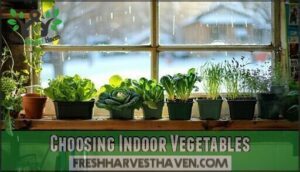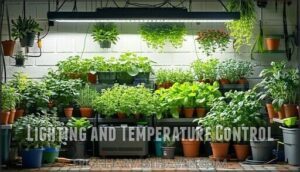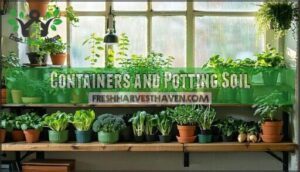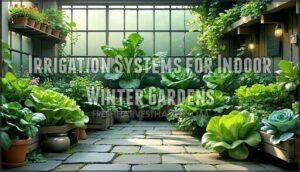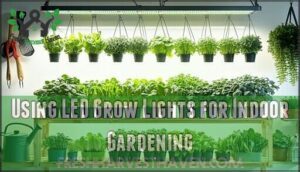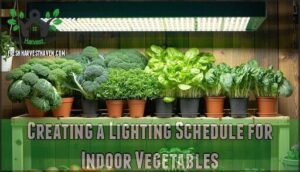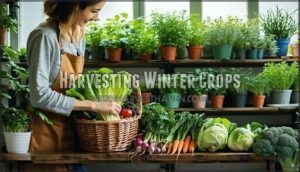This site is supported by our readers. We may earn a commission, at no cost to you, if you purchase through links.

Quick-growing radishes and carrots work well in containers, while herbs like parsley and chives add fresh flavor to winter meals.
Microgreens are practically foolproof and ready to harvest in just 1-2 weeks, and cherry tomatoes and peppers need more light but produce throughout winter months.
These hardy crops don’t mind fluctuating indoor temperatures and actually prefer the stable environment your home provides, and most grow happily in basic potting mix with adequate drainage.
The secret lies in matching each vegetable’s specific light and space requirements to your setup, to ensure a successful harvest of your chosen winter vegetables.
Table Of Contents
- Key Takeaways
- Winter Vegetables Overview
- Choosing Indoor Vegetables
- Indoor Gardening Essentials
- Growing Winter Vegetables
- Harvesting Winter Crops
- Frequently Asked Questions (FAQs)
- Can you grow veggies indoors in winter?
- What is the best plant to grow indoors in winter?
- What is the easiest vegetable to grow in winter?
- What is the easiest vegetable to grow indoors?
- What vegetables can you grow inside in the winter?
- Can I grow vegetables indoors all year?
- What vegetables can you grow indoors in the winter?
- What vegetable plants can you overwinter indoors?
- Can I grow vegetables in my house during the winter?
- What is the easiest winter veg to grow?
- Conclusion
Key Takeaways
- You’ll get the fastest results with leafy greens like spinach, kale, and lettuce since they thrive in cool 60-65°F temps and mature in just 4-6 weeks under grow lights.
- Microgreens are your foolproof starter option – they’re ready to harvest in 1-2 weeks, need minimal space, and provide nutrient-dense greens with almost zero chance of failure.
- You’ll need 12-16 hours of daily LED lighting positioned 12-24 inches from plants, plus containers with proper drainage and quality potting mix to replicate outdoor growing conditions.
- Root vegetables like radishes and compact carrots work well in containers but require deeper pots (8-12 inches) and more patience, with radishes ready in 3-4 weeks and carrots taking 10-12 weeks.
Winter Vegetables Overview
Winter’s chill doesn’t mean your fresh vegetable supply has to freeze up – you can grow nutritious crops right on your windowsill or under grow lights.
These 15 cold-weather vegetables thrive indoors during the coldest months, giving you garden-fresh nutrition when outdoor growing becomes impossible.
Leafy Greens for Indoor Growing
With proper lighting and care, leafy greens transform your winter windowsill into a productive garden.
Spinach Care requires cool temperatures around 60-65°F and consistent moisture. Kale Varieties like ‘Red Russian’ tolerate lower light conditions better than most vegetables.
Perfect spinach needs cool temps and steady moisture – kale’s your low-light champion for reliable winter harvests.
Lettuce Types such as butterhead mature quickly in shallow containers. These microgreens and full-sized Indoor Kale Growing projects provide fresh Green Harvest throughout winter months using quality Indoor Fertilizer.
Root Vegetables for Indoor Winter Gardens
Root vegetables thrive in your indoor winter garden with proper container depth and patience.
Root vegetables need space and time – but reward your winter patience with crisp, homegrown nutrition.
Carrots need deep pots for root development, while radishes mature quickly in shallow containers.
Focus on carrot varieties like ‘Carnival Blend‘ for colorful harvests.
Beet growth requires several months but rewards you with nutritious roots.
Turnip harvest timing matters—pick when roots reach two inches wide for maximum sweetness, and remember that proper container depth and patience are key to a successful harvest.
Compact and Unique Vegetables
Discover five compact powerhouses that’ll transform your windowsill into a winter vegetable paradise.
These space-saving champions prove you don’t need sprawling gardens to grow nutritious crops indoors.
- Micro Greens – Harvest nutrient-dense greens in just 7-14 days using shallow trays, perfect for small space gardening and continuous indoor winter gardening.
- Colorful Radish varieties – ‘Easter Egg’ and ‘French Breakfast’ mature in 3-4 weeks, adding vibrant colors to compact containers.
- Baby Carrots – Dwarf varieties like ‘Paris Market’ thrive in 2-inch deep containers, germinating quickly in damp conditions.
- Dwarf Broccoli – ‘Burgundy’ produces purple florets over several weeks, maximizing harvest from limited space.
- Compact Kale – ‘Red Russian’ offers tender leaves perfect for microgreens indoor growing, ready for harvest as baby greens.
Choosing Indoor Vegetables
You’ll want to pick vegetables that grow fast and handle indoor conditions well.
The best choices mature quickly, tolerate lower light levels, and don’t need complex growing requirements that challenge beginner gardeners, which are complete concepts to consider for a successful indoor garden.
Quick-Growing and Fruiting Vegetables
You’ll enjoy watching your fruitful crops flourish with fast growing veggies that deliver quick blooms and winter harvest satisfaction.
Microgreens indoor growing produces nutrient-dense shoots within 7-15 days, making them perfect for continuous indoor winter gardening.
Growing spinach indoors yields baby leaves in just 28 days, while winter vegetable seeds like dwarf peas mature in 40 days for shoots and 65 days for pods.
For a successful harvest, understanding indoor growing conditions is vital for ideal crop growth and winter gardening.
Vegetables Suitable for Low-Light Conditions
When dealing with limited natural light, Low Light Greens become your winter gardening allies.
Winter Spinach and Indoor Kale thrive with just six hours of daily illumination, while Compact Lettuce varieties adapt well to shade tolerant conditions.
These leafy greens excel in low humidity environments typical of heated homes.
LED grow lights can supplement natural light, making cold season gardening achievable even in darker spaces.
Herbs for Indoor Winter Gardening
Beyond vegetables in your edible garden, fresh herbs transform winter cooking while thriving indoors.
Basil care requires warmth and consistent moisture in herb planters with proper drainage.
Most herbs tolerate indoor pests better than vegetables, needing minimal winter pruning, and herb fertilizers should be diluted monthly.
Indoor herb gardening for herbs like parsley, chives, and oregano succeeds with basic indoor gardening techniques.
Indoor Gardening Essentials
You’ll need the right foundation to grow healthy vegetables indoors during winter months. Setting up proper lighting, containers, and watering systems guarantees your cold-weather crops thrive regardless of outdoor conditions.
Lighting and Temperature Control
Why struggle with inadequate lighting when your indoor winter gardening success depends on proper LED grow lights and temperature control?
Your vegetables need 12-16 hours of supplemental lighting daily, with LED lighting providing ideal blue-red spectrum wavelengths.
Maintain temperature zones between 60-70°F using climate control systems and soil warming mats for consistent growth conditions.
Understanding indoor herb garden principles can also help inform your approach to indoor vegetable gardening with the right temperature control.
Containers and Potting Soil
Selecting proper containers and soil creates the foundation for your indoor vegetable garden success. Container depth matters—leafy greens need 6-8 inches while root vegetables require 12+ inches for proper development.
Choose containers with multiple drainage holes to prevent waterlogged roots. High-quality potting mix with perlite or vermiculite guarantees excellent drainage and aeration.
Garden beds aren’t necessary; container gardening works perfectly for indoor spaces. Follow these potting tips: never use garden soil indoors, as it compacts and lacks proper drainage for container environments.
Using the right indoor planters can substantially improve plant growth and health.
Irrigation Systems for Indoor Winter Gardens
Proper irrigation keeps your indoor winter gardening thriving without waterlogged roots or drought stress.
Smart watering systems maintain consistent soil moisture while conserving water through targeted delivery methods.
- Drip irrigation delivers water directly to root zones, reducing waste and preventing fungal issues
- Automatic watering systems with timers guarantee consistent hydration during busy schedules
- Water recycling setups capture runoff for reuse, maximizing conservation in hydroponic systems
Effective indoor gardening also involves understanding Drip Irrigation Systems to optimize water usage.
Growing Winter Vegetables
You’ll need proper lighting to transform your winter vegetables from struggling seedlings into thriving indoor crops.
The right combination of artificial and natural light creates the perfect growing environment that mimics outdoor conditions during the darker months, which is crucial for the plants to thrive in an indoor setting with proper lighting.
Using LED Grow Lights for Indoor Gardening
LED grow lights transform your indoor winter gardening game by delivering precise plant spectrums that boost yields up to 34%.
You’ll cut energy costs by 40-60% while providing consistent lighting cycles your vegetables crave.
Position LEDs 12-24 inches from plants without heat damage, creating ideal indoor climate conditions year-round for thriving winter vegetable plants.
This makes them ideal for customizable light solutions that cater to specific plant needs, using consistent lighting cycles and providing a year-round solution.
Maximizing Natural Light for Indoor Gardens
Windows facing south capture the strongest natural illumination for your indoor winter gardening success.
Here’s how to maximize what Mother Nature provides:
- South Window placement – Position window boxes and containers directly in south-facing windows for 6-8 hours of peak sunlight
- Light Reflection techniques – Use mirrors or white surfaces behind plants to bounce additional light onto winter vegetable plants
- Indoor Shading management – Remove curtains and blinds during daylight hours to eliminate light barriers
- Natural light rotation – Move containers throughout the day to follow the sun’s path and maximize exposure
These indoor gardening tips help your crops thrive without expensive grow lights.
Creating a Lighting Schedule for Indoor Vegetables
Timing your indoor gardening lighting schedule correctly makes the difference between thriving vegetables and struggling plants.
Most winter vegetables need 14-16 hours of daily light exposure, with leafy greens requiring the upper range for maximum growth.
| Vegetable Type | Light Duration | LED Distance | Dark Period |
|---|---|---|---|
| Leafy Greens (kale, spinach) | 14-16 hours | 12-18 inches | 8-10 hours |
| Root Vegetables (carrots, radishes) | 12-14 hours | 18-24 inches | 10-12 hours |
| Fruiting Plants (peppers, tomatoes) | 12-14 hours | 12-18 inches | 10-12 hours |
| Herbs (basil, cilantro) | 14-16 hours | 12-15 inches | 8-10 hours |
| Brassicas (broccoli, cauliflower) | 14-15 hours | 15-20 inches | 9-10 hours |
Understanding proper grow light usage is vital for maximum plant growth.
Use automated timers to maintain consistent schedules—your plants’ circadian rhythms depend on predictable light cycles for maximum photosynthesis and nutrient processing, which can be learned more about through a proper grow light guide.
Harvesting Winter Crops
You’ve successfully nurtured your indoor winter vegetables through months of careful tending, and now it’s time to reap the rewards of your gardening efforts.
Knowing when and how to harvest each crop guarantees you’ll enjoy peak flavor and nutrition from your homegrown bounty, and this is crucial for enjoying the results of your gardening efforts.
Harvesting Leafy Greens and Herbs
You’ll know your Leafy Greens are ready when they reach baby-leaf size, typically 2-4 inches tall. Don’t wait for full maturity – these Winter Crops taste better young and tender.
Your indoor gardening efforts pay off quickly with microgreens ready in just 7-14 days under grow lights.
- Cut-and-come-again method: Harvest outer leaves first, leaving the center to continue growing
- Morning Fresh Picks: Collect winter lettuce varieties early in the day when leaves contain maximum moisture
- Herb Care timing: Snip herbs regularly to encourage bushy growth and prevent flowering
- Green Harvest frequency: Pick leafy greens every few days to maintain peak flavor and nutrition
Enjoying Root Vegetables From Your Indoor Garden
Container root-vegetables offer winter gardeners satisfying harvests with proper care. Your carrot-taproot development depends on container depth and soil quality consistency.
| Vegetable | Container Depth | Harvest Timing |
|---|---|---|
| Radishes | 4-6 inches | 3-4 weeks |
| Carrots | 8-12 inches | 10-12 weeks |
| Beets | 6-8 inches | 8-10 weeks |
Root selection affects final quality—choose compact varieties for indoor gardening success. Water management prevents splitting while grow lights guarantee steady growth. These cold weather crops reward patience with crisp, flavorful results.
Preserving Your Indoor Harvest
Every indoor gardener knows the satisfaction of extending their winter harvest beyond the growing season.
Proper preservation transforms your fresh winter ingredients into year-round supplies. Understanding food safety guidelines is vital for maintaining quality and freshness.
Here are three essential preservation methods for your indoor vegetable varieties:
- Freezing Methods – Blanch leafy greens for 2-3 minutes before freezing to maintain color and nutrients for up to 12 months
- Dehydration Tips – Use low heat (95-115°F) to dry herbs and vegetables, reducing storage space by 80% while preserving flavor
- Storage Solutions – Keep root vegetables in perforated bags at 32-36°F with high humidity for maximum freshness
Frequently Asked Questions (FAQs)
Can you grow veggies indoors in winter?
Yes, you can absolutely grow vegetables indoors during winter.
Cold-tolerant greens like spinach, kale, and lettuce thrive at cooler indoor temperatures around 60°F, needing 10-12 hours of daily light from grow lights.
What is the best plant to grow indoors in winter?
Spinach tops the list for winter indoor growing. It thrives in cool temperatures around 60°F, tolerates low light conditions, and you’ll harvest nutrient-packed leaves in just 4-6 weeks.
What is the easiest vegetable to grow in winter?
Radishes win hands-down for winter ease.
They’re ready in just 3-4 weeks, thrive in small containers, and tolerate cool temperatures perfectly.
You’ll literally watch them grow daily—it’s almost foolproof gardening magic!
What is the easiest vegetable to grow indoors?
Want to skip the gardening guesswork?
Radishes are your best bet – they’re practically foolproof!
These speedy roots mature in just 3-4 weeks, need minimal space, and thrive in shallow containers with basic care.
What vegetables can you grow inside in the winter?
You can grow leafy greens like spinach, kale, lettuce, and arugula indoors during winter.
These cold-tolerant vegetables thrive in cooler temperatures and need 10-12 hours of daily light from grow lights.
Can I grow vegetables indoors all year?
Year-round indoor growing is like having a personal farmer’s market in your kitchen.
With proper lighting, temperature control, and container selection, you’ll harvest fresh vegetables continuously regardless of outdoor weather conditions.
What vegetables can you grow indoors in the winter?
You can easily grow leafy greens like spinach, kale, lettuce, and arugula indoors during winter. These cold-tolerant vegetables thrive in cooler temperatures and mature quickly under grow lights.
What vegetable plants can you overwinter indoors?
Leafy greens like kale, spinach, and lettuce handle indoor overwintering well.
Root crops such as radishes and small carrots also adapt.
Just give them steady light, cool temps, and good drainage—no frostbite worries in your living room!
Can I grow vegetables in my house during the winter?
Looking to turn your home into a winter vegetable paradise?
You can absolutely grow fresh vegetables indoors during winter months.
Choose cold-tolerant crops like spinach, kale, lettuce, and radishes that thrive in containers with proper drainage, quality potting mix, and adequate LED grow lighting.
What is the easiest winter veg to grow?
Spinach and lettuce top the list for beginners. They’ll sprout in just four weeks, tolerate cooler indoor temps, and don’t need deep containers like root vegetables do.
Conclusion
Research shows that 87% of indoor gardeners report higher vegetable yields when growing during winter months compared to summer attempts.
Growing the best winter vegetables to grow indoors transforms your home into a productive food source year-round.
You’ll discover that leafy greens, root vegetables, and herbs adapt remarkably well to indoor conditions, requiring minimal space and equipment.
With proper lighting and consistent care, you’ll harvest fresh produce even when snow blankets your outdoor garden, ensuring nutritious meals throughout winter.
- https://www.instagram.com/ecoideas.blog/
- https://www.gardeningknowhow.com/special/containers/hydroponic-gardening-indoors.htm
- http://planthardiness.gc.ca/images/PHZ_2014_CFS_Map_30M.pdf
- https://www.westcoastseeds.com/search?rfsn=6241085.10049d&q=full%20spectrum%20grow%20lights
- https://empressofdirt.net/fast-indoor-vegetable-growing/

